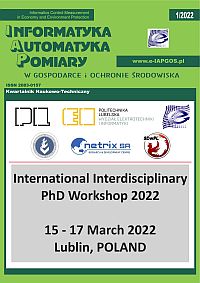APPLICATION OF CONVOLUTIONAL NEURAL NETWORKS IN WALL MOISTURE IDENTIFICATION BY EIT METHOD
Article Sidebar
Open full text
Issue Vol. 12 No. 1 (2022)
-
METHODS FOR ENSURING DATA SECURITY IN MOBILE STANDARDS
Serhii Moroz, Anatolii Tkachuk, Mykola Khvyshchun, Stanislav Prystupa, Mykola Yevsiuk4-9
-
HYBRID NAVIGATION SYSTEM FOR INDOOR USE
Michał Styła, Przemysław Adamkiewicz10-14
-
INDOOR LOCALIZATION SYSTEM USING UWB
Dominik Gnaś, Przemysław Adamkiewicz15-19
-
APPLICATION OF CONVOLUTIONAL NEURAL NETWORKS IN WALL MOISTURE IDENTIFICATION BY EIT METHOD
Grzegorz Kłosowski, Tomasz Rymarczyk20-23
-
TILTED FIBER BRAGG GRATING SENSORS FOR REFRACTIVE INDEX MEASUREMENTS OF LIQUID SOLUTIONS
Damian Harasim24-27
-
OPTIMISATION OF COMMERCIAL BUILDING MANAGEMENT PROCESSES USING USER BEHAVIOUR ANALYSIS SYSTEMS SUPPORTED BY COMPUTATIONAL INTELLIGENCE AND RTI
Michał Styła, Przemysław Adamkiewicz28-35
-
Development of deposition technology and AC measurement of copper ultrathin layers
Aleksandra Wilczyńska, Karolina Czarnacka, Andrzej Kociubiński, Tomasz Kołtunowicz36-39
-
NEURAL NETWORKS FROM KERAS IN SKIN LESION DIAGNOSTIC
Magdalena Michalska-Ciekańska40-43
-
DETERMINING THE WORKING LENGTH OF A ROOT CANAL USING INTRAORAL RADIOGRAPHY SEGMENTATION
Oleksii Perepelytsia, Tetyana Nosova44-46
Archives
-
Vol. 14 No. 4
2024-12-21 25
-
Vol. 14 No. 3
2024-09-30 24
-
Vol. 14 No. 2
2024-06-30 24
-
Vol. 14 No. 1
2024-03-31 23
-
Vol. 13 No. 4
2023-12-20 24
-
Vol. 13 No. 3
2023-09-30 25
-
Vol. 13 No. 2
2023-06-30 14
-
Vol. 13 No. 1
2023-03-31 12
-
Vol. 12 No. 4
2022-12-30 16
-
Vol. 12 No. 3
2022-09-30 15
-
Vol. 12 No. 2
2022-06-30 16
-
Vol. 12 No. 1
2022-03-31 9
-
Vol. 11 No. 4
2021-12-20 15
-
Vol. 11 No. 3
2021-09-30 10
-
Vol. 11 No. 2
2021-06-30 11
-
Vol. 11 No. 1
2021-03-31 14
-
Vol. 10 No. 4
2020-12-20 16
-
Vol. 10 No. 3
2020-09-30 22
-
Vol. 10 No. 2
2020-06-30 16
-
Vol. 10 No. 1
2020-03-30 19
Main Article Content
DOI
Authors
tomasz.rymarczyk@netrix.com.pl
Abstract
The article presents the results of research in the area of using deep neural networks to identify moisture inside the walls of buildings using electrical impedance tomography. Two deep neural networks were used to transform the input measurements into images of damp places - convolutional neural networks (CNN) and recurrent long short-term memory networks LSTM. After training both models, a comparative assessment of the results obtained thanks to them was made. The conclusions show that both models are highly utilitarian in the analyzed problem. However, slightly better results were obtained with the LSTM method.
Keywords:
References
Fabijańska A., Banasiak R.: Graph Convolutional Networks for Enhanced Resolution 3D Electrical Capacitance Tomography Image Reconstruction. Applied Soft Computing 110, 2021, 107608, [http://doi.org/10.1016/J.ASOC.2021.107608]. DOI: https://doi.org/10.1016/j.asoc.2021.107608
Hola A.: Measuring of the Moisture Content in Brick Walls of Historical Buildings-the Overview of Methods. IOP Conference Series: Materials Science and Engineering 251(1), 2017, [http://doi.org/10.1088/1757-899X/251/1/012067]. DOI: https://doi.org/10.1088/1757-899X/251/1/012067
Kłosowski G. et al.: Quality Assessment of the Neural Algorithms on the Example of EIT-UST Hybrid Tomography. Sensors 20(11), 2020, [http://doi.org/10.3390/s20113324]. DOI: https://doi.org/10.3390/s20113324
Kłosowski G. et al.: The Concept of Using Lstm to Detect Moisture in Brick Walls by Means of Electrical Impedance Tomography. Energies 14(22), 2021, [http://doi.org/10.3390/en14227617]. DOI: https://doi.org/10.3390/en14227617
Litti G. et al.: Hygrothermal Performance Evaluation of Traditional Brick Masonry in Historic Buildings. Energy and Buildings 105, 2015, 393–411, [http://doi.org/10.1016/j.enbuild.2015.07.049]. DOI: https://doi.org/10.1016/j.enbuild.2015.07.049
Porzuczek J.: Assessment of the Spatial Distribution of Moisture Content in Granular Material Using Electrical Impedance Tomography. Sensors 19(12), 2019, 2807, [http://doi.org/10.3390/s19122807]. DOI: https://doi.org/10.3390/s19122807
Romanowski A. et al.: X-Ray Imaging Analysis of Silo Flow Parameters Based on Trace Particles Using Targeted Crowdsourcing. Sensors 19(15), 2019, 3317, [http://doi.org/10.3390/s19153317]. DOI: https://doi.org/10.3390/s19153317
Rymarczyk T. et al.: Area Monitoring Using the ERT Method with Multisensor Electrodes. Przegląd Elektrotechniczny 95(1), 2019, [http://doi.org/10.15199/48.2019.01.39]. DOI: https://doi.org/10.15199/48.2019.01.39
Rymarczyk T., Adamkiewicz P.: Nondestructive Method to Determine Moisture Area in Historical Building. Informatics Control Measurement in Economy and Environment Protection 7(1), 2017, [http://doi.org/10.5604/01.3001.0010.4586]. DOI: https://doi.org/10.5604/01.3001.0010.4586
Article Details
Abstract views: 484
License

This work is licensed under a Creative Commons Attribution-ShareAlike 4.0 International License.






